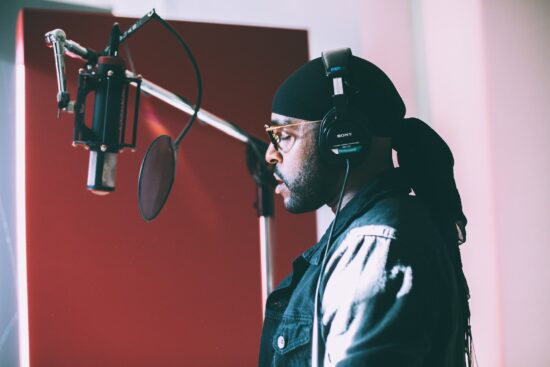It’s hard to know where to start when beginning to produce your own music and recording vocals can be extremely challenging. There are many different ways to go about it, depending on the style and tone you’re going for, and the equipment you have access to will also affect what you can and can’t do. So a lot of it is going to be down to experimentation but with these expert tips, you can begin to work out what sounds and suits you best.
The Room
The first thing to consider is the space you are recording in. Now, you may not have a lot of choice in the matter of choosing a room, you might be confined to your bedroom for example, and that’s okay. Auto-tune nowadays is essential in vocal production, particularly if you are a home studio producer, because it can help give an extremely impressive and professional sound, even from a bedroom. This means you can use the same vocal production tools that many professional studios depend on.
The key to enhancing a room is by limiting reverb. Things like pitch correction and heavy dynamic processing will not be as effective if vocal recordings have reverb. Having a room with a lot of soft furniture and materials (like duvets) can help absorb sound, and avoiding areas like a kitchen of places with wooden floors can help too. However, you can make a room too high in sound absorption, which will create an unnatural sound when recording vocals, so it’s important to find a balance.
The Microphone
The Type
Choosing a microphone will depend on your budget, but other things like the genre of music and the voice of the vocalist will also need to be considered. There are three main types of microphones: dynamic (cheap, less sensitive to loud sounds, and very versatile), condenser (a bit more expensive, enhances sounds, relatively versatile), and ribbon mics (very expensive, vintage). In most cases, for vocals, particularly for home production, condenser microphones are your best bet, but a dynamic mic is best for more aggressive singers, such as heavy metal.

The Placement
The microphone should be placed in the room as far away from the walls as you can because these reflect sound, but also do not place it right in the middle of the room, which has a buildup of standing waves. Standing waves are areas of high and low pressure that interfere with the recording process, so avoiding these is a must.
The effects of the angle of the microphone can also change the sound. A microphone placed below lip level will produce brighter-sounding vocals because it picks up higher frequencies. However, because it’s closer to the chest, some bass sounds are also picked up. Moving the microphone higher up reduces both the high frequencies and the bass frequencies, meaning a more balanced midrange sound is created.
Vocalist Distance and Positioning
The placement of the vocalist, such as distance and angles, can make a big difference. This is something you should spend some time experimenting with because it can depend on their timbre and how loudly they sing. The microphone should also be angled so the centre is not quite directly facing the vocalist’s mouth because this part of the mic can be extremely sensitive. Whilst recording, make sure the vocalist is staying as still as possible, especially their head and feet, although an experienced vocalist can play with drawing further away from the mic for louder notes. Using a visual aid can help them stay as still as they can so they don’t change the angle that they are singing into the mic.
Preventing Popping and Sibilance
A pop filter is a noise filter used in front of a microphone to reduce popping sounds caused by the pronunciation of plosive sounds in speech (plosives include sounds made by the letters p, t, b). It is possible to make your own pop filter by stretching tights over a kitchen sieve, although professionally-made ones filter the air and frequencies better.
Sibilance is the sounds of s and t, which are very high frequency and can ruin a good take. This can be prevented by positioning the mic above lip level or can be tamed using specialist compressors.

The Vocalist’s Technique
Make sure the vocalist is comfortable and happy with the set-up, to ensure your recording will be successful. You want them to be relaxed so that they give a good performance and are able to rerecord as many times as you need. Take time to make sure the headphone mix is right so they can hear themselves properly, sometimes more reverb for their mix can help improve their pitching. Also, make sure the room temperature is at a good level; but be aware that air conditioning can affect a vocalist’s airways and can interfere with the microphone, too.
Making a unique and special vocal track is going to depend on the original performance given. Auto-tuning, mixing, and editing can all help but this just enhances the natural take. It’s therefore crucial that you encourage a meaningful and epic recording session. Many artists in the past have found ways to help this: some have a live band in with them to help give a more energetic recording, some don’t listen to a headphone mix at all, and some choose to record in rooms other than studios to play with the acoustics and sounds.
All in all, the better you get the original take, the more natural it’s going to sound and the easier it’s going to be to mix. Investing in a good mic and taking care of the set-up will make a world of difference. The room should limit reverb and absorb sounds to a certain degree, otherwise, you risk the atmosphere of the vocal take being two-dimensional. You also need to think about the placement of the mic in the room, the angle of it, and the distance the vocalist is away – it’s important to experiment with these. Then, it’s vital the vocalist is working in an environment where they can give their best performance, which you then can have the pleasure of mixing and producing.








